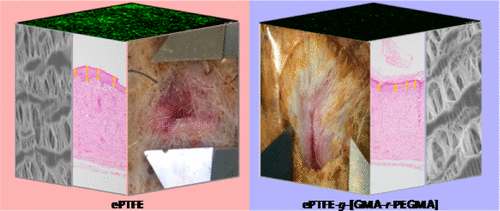当前位置:
X-MOL 学术
›
ACS Biomater. Sci. Eng.
›
论文详情
Our official English website, www.x-mol.net, welcomes your
feedback! (Note: you will need to create a separate account there.)
Turning Expanded Poly(tetrafluoroethylene) Membranes into Potential Skin Wound Dressings by Grafting a Bioinert Epoxylated PEGMA Copolymer
ACS Biomaterials Science & Engineering ( IF 5.4 ) Pub Date : 2017-11-07 00:00:00 , DOI: 10.1021/acsbiomaterials.7b00732 Antoine Venault,Cheng-Sian Liou,Lu-Chen Yeh,Jheng-Fong Jhong,James Huang,Yung Chang
ACS Biomaterials Science & Engineering ( IF 5.4 ) Pub Date : 2017-11-07 00:00:00 , DOI: 10.1021/acsbiomaterials.7b00732 Antoine Venault,Cheng-Sian Liou,Lu-Chen Yeh,Jheng-Fong Jhong,James Huang,Yung Chang

|
Despite a set of properties ideal to the design of wound dressings, bioinert membranes are seldom applied as wound-healing systems. This work presents a unique series of random copolymers of glycidyl methacrylate (GMA) and poly(ethylene glycol) methacrylate (PEGMA), namely GMA-r-PEGMA, used to surface-modify by grafting onto method polytetrafluorethylene membranes, with the aim of developing wound dressings for quick and efficient wound closure. It is shown that the membrane modified with G50P50 copolymer combines high surface hydrophilicity, high porosity, protein resistance, bacterial resistance, and hemocompatibility, essential properties to wound dressings. Fibrinogen adsorption was measured to be 11.4 ± 3.9% (compared with virgin membrane) correlating with a low water contact angle (14°), whereas the attachment of fluorescent Escherichia coli after 24 h, erythrocytes, leukocytes, thrombocytes, and cells from whole blood was reduced by 85–90%, compared with the virgin membrane. G50P50 membrane was tested as a wound dressing, which outperformed hydrophilic gels of PEGMA in terms of wound-closure kinetic and a commercial dressing in terms of homogeneity of the granulation layer. The facile surface-modification of ePTFE membrane using unique GMA-r-PEGMA copolymer leads to an antibiofouling porous material with improved hemocompatibility combining numerous essential properties of wound dressings and contributing toward the development of the ideal bandage.
中文翻译:

通过接枝生物惰性的环氧PEGMA共聚物将膨胀的聚四氟乙烯膜转变成潜在的皮肤伤口敷料
尽管有一系列适合伤口敷料设计的特性,但生物惰性膜很少被用作伤口愈合系统。这项工作提出了一系列独特的甲基丙烯酸缩水甘油酯(GMA)和聚(乙二醇)甲基丙烯酸乙二醇酯(PEGMA)的无规共聚物,即GMA- r-PEGMA,用于通过接枝到方法聚四氟乙烯膜上进行表面修饰,目的是开发伤口敷料,以快速有效地闭合伤口。结果表明,用G50P50共聚物改性的膜兼具高表面亲水性,高孔隙率,抗蛋白质性,抗细菌性和血液相容性,这是伤口敷料必不可少的特性。纤维蛋白原的吸附被测量为11.4±3.9%(与原生膜相比),与低水接触角(14°)相关,而荧光大肠杆菌的附着24小时后,与原始膜相比,全血中的红细胞,白细胞,血小板和全血细胞减少了85–90%。测试了G50P50膜作为伤口敷料,就伤口闭合动力学而言,它的性能优于PEGMA的亲水性凝胶,而就造粒层的均匀性而言,其性能优于商业敷料。使用独特的GMA- r- PEGMA共聚物对ePTFE膜进行轻松的表面修饰,可制得具有改善的血液相容性的抗污垢多孔材料,结合了伤口敷料的许多基本特性,并为开发理想的绷带做出了贡献。
更新日期:2017-11-07
中文翻译:

通过接枝生物惰性的环氧PEGMA共聚物将膨胀的聚四氟乙烯膜转变成潜在的皮肤伤口敷料
尽管有一系列适合伤口敷料设计的特性,但生物惰性膜很少被用作伤口愈合系统。这项工作提出了一系列独特的甲基丙烯酸缩水甘油酯(GMA)和聚(乙二醇)甲基丙烯酸乙二醇酯(PEGMA)的无规共聚物,即GMA- r-PEGMA,用于通过接枝到方法聚四氟乙烯膜上进行表面修饰,目的是开发伤口敷料,以快速有效地闭合伤口。结果表明,用G50P50共聚物改性的膜兼具高表面亲水性,高孔隙率,抗蛋白质性,抗细菌性和血液相容性,这是伤口敷料必不可少的特性。纤维蛋白原的吸附被测量为11.4±3.9%(与原生膜相比),与低水接触角(14°)相关,而荧光大肠杆菌的附着24小时后,与原始膜相比,全血中的红细胞,白细胞,血小板和全血细胞减少了85–90%。测试了G50P50膜作为伤口敷料,就伤口闭合动力学而言,它的性能优于PEGMA的亲水性凝胶,而就造粒层的均匀性而言,其性能优于商业敷料。使用独特的GMA- r- PEGMA共聚物对ePTFE膜进行轻松的表面修饰,可制得具有改善的血液相容性的抗污垢多孔材料,结合了伤口敷料的许多基本特性,并为开发理想的绷带做出了贡献。











































 京公网安备 11010802027423号
京公网安备 11010802027423号